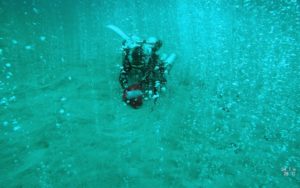by Cap Allon, January 27, 2020 in Electroverse
University of Texas at Austin Professor, Bayani Cardenas, has discovered an underwater environment of bubbling carbon dioxide with readings some 200x the concentration of CO2 in the atmosphere.
Cardenas discovered the region –which he calls “Soda Springs”– while studying how groundwater from a nearby island could affect the ocean environment of the Verde Island Passage in the Philippines. The passage is one of the most diverse marine ecosystems in the world and is home to thriving coral reefs.
The amazing bubbling location, which Cardenas captured on video, is not a climate change nightmare, reads part of the press release issued by utexas.edu on Jan 22, 2020. It is instead linked to a nearby volcano that vents out the gases through cracks in the ocean floor, and has probably been doing so for decades or even millennia.

When geoscientist Cardenas went diving off the coastline of the Calumpan Peninsula, he and his coauthors found the ocean floor bubbling like champagne, pumping out vast amounts of carbon dioxide. The team dove about 60 meters (200 feet) down into “Soda Springs” where they measured CO2 concentrations from 60,000 ppm to as high as 95,000 ppm — more than 200 times the concentration of CO2 in the atmosphere. The scientists traced the bubbles down to their source, and discovered cracks in the ocean floor venting gasses from an underwater volcano.
Robert Felix of iceagenow.info writes, “when you remember that there are more than three million underwater volcanoes, and that they could all be pumping out similar amounts of CO2, well, you get my drift…”
The CO2 levels quickly fall away from the seeps as the gas is diluted in the ocean, but the gas still creates an elevated CO2 environment along the rest of the coastline of the Calumpan Peninsula, with levels in the 400 to 600 ppm range — and life is flourishing!
“These high CO2 environments that are actually close to thriving reefs,” said Cardenas, “how does it work?”
Carbon Dioxide is essential for biodiversity — our planet teems with life when levels of the stuff are high. As Dr. Patrick Moore said at the Water, Oceans and Wildlife Subcommittee Hearing last May:
“First of all, there is no hard evidence that CO2 has anything to do with the changing temperature of the Earth’s climate. Secondly, CO2 is the most important food for all life on earth.
“All the carbon in all carbon based life … came from carbon dioxide, in the air and the water. Carbon dioxide has been declining steadily for the last 150 million years to its lowest level in the history of life on earth, at the height of the last glaciation — 180 ppm. The reason for this is that life itself has sucked the carbon out of the system and put it into the sediments as fossil fuels–but much more importantly as carbonaceous rocks (a fancy term for limestone). That’s where all the carbon went and we, thankfully, are putting some of the CO2 back into the air that was sucked out by life over the millennia and are restoring a balance to the global carbon cycle.
“At 150 ppm carbon dioxide in the atmosphere plants die. They don’t just need carbon dioxide to survive, they need a certain level of it, just like we need a certain level of oxygen, to survive.
“Virtually all commercial greenhouse growers enrich the atmosphere in their greenhouse with between two to three times the level [of CO2] in the global atmosphere today in order to get 20 to 60 percent increase in growth. And indeed, this is happening globally as we have increased CO2 from 280 ppm to 410 ppm — a greening of the earth is occurring, NASA has it on their website, the Australian scientists and the European scientist all confirm that there has been a massive greening of the earth.”
